Trinity Logistics, a national third-party logistics provider (3PL), is proud to announce its 2024 Platinum Agents. This distinguished group of Independent Freight Agents is recognized for their outstanding brokerage achievements in 2024. Thirty-five Agent offices earned Platinum status, with 11 of those achieving the newly-recognized, elite Platinum Plus level. These remarkable recipients represent 16 states across the U.S. and Mexico, highlighting the diverse and far-reaching impact of Trinity’s Agent network.
The Platinum recognition celebrates Agent offices that achieve at least $500,000 in annual brokerage, while Platinum Plus status is awarded to those exceeding $1.5 million. Since the program’s inception in 2018, the Platinum awards have honored top-performing Agents for their dedication to delivering exceptional logistics solutions.
“To achieve Platinum status in any year is a testament to the successful businesses our Agents have built,” said Greg Massey, Senior Vice President of Agent Development. “Results like these don’t just happen – they require dedication, determination, and a true passion for the work. Trinity is incredibly proud of their achievements, many of which are repeat recognitions, and we look forward to celebrating with them in June.”
To recognize their accomplishments, Trinity is thrilled to reward its Platinum Agents with an all-expenses-paid getaway to Barbados. This exclusive trip offers the honorees and their guests a well-deserved opportunity to recharge in a relaxing environment, network with peers, and celebrate their shared success.
Trinity’s Agent Program has been a cornerstone of the company’s business model for 35 years, supporting Independent Freight Agents with tools, resources, and a collaborative network. The Platinum awards, now in their sixth year, symbolize the program’s commitment to fostering success and celebrating excellence.
LEARN MORE ABOUT TRINITY DISCOVER FREIGHT AGENT PROGRAMAbout Trinity Logistics
Trinity Logistics is a Burris Logistics Company, offering People-Centric Freight Solutions®. Our mission is to deliver creative logistics solutions through a mix of human ingenuity and innovative technology, enriching the lives of those we serve.
For the past 45 years, we’ve been arranging freight for businesses of all sizes in truckload, less-than-truckload (LTL), warehousing, intermodal, drayage, expedited, international, and technology solutions.
We are currently recognized as a Top Freight Brokerage by Transport Topics, a Green Supply Chain Partner by Inbound Logistics, and holds a silver sustainability rating by EcoVadis.
Trinity Logistics, a leading, nationwide third-party logistics provider (3PL), is thrilled to announce the appointment of Gabrielle Macy as its Vice President of Administrative Services.
Macy comes to Trinity Logistics with a well-rounded history of roles that made her an optimal choice for the position. She brings nearly 20 years of extensive experience in administrative leadership and organizational development. Her expertise in transforming administrative functions and driving organizational growth aligns perfectly with Trinity’s commitment to excellence and continuous improvement.
“Gabrielle’s broad and extensive background in various positions including her previous roles as Executive Vice President of Operations and Chief Operating Officer certainly made her stand out for the position,” said Doug Potvin, Chief Financial Officer at Trinity Logistics. “She also has significant knowledge of technology and how it should be implemented to improve efficiency and effectiveness. But what truly set Gabrielle apart from other candidates is her incredible personality and dedication to nurturing others, making her an ideal fit for Trinity’s People-Centric culture.”
In her new role, Gabrielle will oversee all aspects of Administrative Services, including Credit, Collections, Risk, Invoicing, Carrier Compliance, and Claims. Her commitment to fostering a positive and productive work environment will make her a notable addition to Trinity’s leadership.
“The logistics industry is ripe with opportunity to drive meaningful impact, particularly in today’s fast-paced and interconnected global economy,” said Macy. “I am honored to join Trinity, a company that not only delivers exceptional logistics solutions but does so by prioritizing relationships, empowering its people, and embracing innovation.”
Macy is eager to foster growth within Trinity by enabling teams to reach their fullest potential. By cultivating a culture of trust, engagement, and continuous improvement, she aims to inspire and support every Team Member to deliver their best work and achieve shared success.
“This is more than a career step for me; it’s an opportunity to be a part of something bigger – a company that aligns its actions with its values and sets a standard of excellence in the industry,” Macy added. “I look forward to contributing Trinity’s legacy and shaping its future as we deliver value to our partners, customers, and communities.”
Trinity looks forward to the insight and experience Macy will bring to its back-end business operations and dedication to offering exceptional service and experiences to our business partners.
LEARN MORE ABOUT TRINITY DISCOVER TRINITY'S SERVICES VIEW CAREERSAbout Trinity Logistics
Trinity Logistics is a Burris Logistics Company, offering People-Centric Freight Solutions®. Our mission is to deliver creative logistics solutions through a mix of human ingenuity and innovative technology, enriching the lives of those we serve.
For the past 45 years, we’ve been arranging freight for businesses of all sizes in truckload, less-than-truckload (LTL), warehousing, intermodal, drayage, expedited, international, and technology solutions.
We are currently recognized as a Top Freight Brokerage by Transport Topics, a Green Supply Chain Partner by Inbound Logistics, and holds a silver sustainability rating by EcoVadis.
March 16 @ 10:00 am – March 18 @ 3:00 pm
IT’S TIME TO REEL IN SUPPLY CHAIN SUCCESS
Are you attending the Seafood Expo this March? Don’t miss your chance to meet some of our Team Members in-person, get a free logistics analysis, and discover how we can keep your logistics from floundering. We’ll be located at booth #1668!!!
Get Hooked on These Specialized Seafood Shipping Benefits
| 🪝Freight Claims Support Our in-house certified Claims Team handles any potential claims so you don’t have to do it alone. | 🪝Strict Operating Procedures Our detailed Seafood SOP ensures we only work with vetted, reliable carrier relationships. |
| 🪝Extra Insurance Coverage Shipping high-value seafood like lobster? We can arrange additional coverage for EXTRA protection. | 🪝Market Expertise and Flexibility From seasonal demand surges to unexpected disruptions, we adapt quickly to keep your supply chain moving. |
Why Trinity Logistics?
We’re committed to making your logistics EASY and be one less thing to hold your business back from its fullest potential. Our 45+ years of experience arranging over 40,000 temperature-controlled shipments annually, attention to detail, and exceptional People-Centric service has made us a leader for companies in the seafood industry! Whether you need help securing refrigerated capacity or arranging drayage from national ports, here’s what you’ll gain by working with us:
⭐ A Dedicated Trinity Representative
You’ll be partnered up with a Trinity expert providing you personalized support and guiding you through solutions to keep operations. Consider this person your one-point-of-contact for all things logistics!
⭐ Experts in Shipping Seafood
We have decades of experience aiding thousands of shippers like you. We can help you navigate complex regulations and mitigate risk, navigating FSMA regulations or temperature sensitivities, making sure your shipments stay compliant and arrive at peak freshness.
Check out our FREE Temperature Shipping Guide!⭐ A Full-Service Logistics Provider
Whether you need refrigerated truckload, LTL, expedited, freight consolidation, crossdocking, one shipment moved or a full outsource, we can help you now and support your business as it grows.
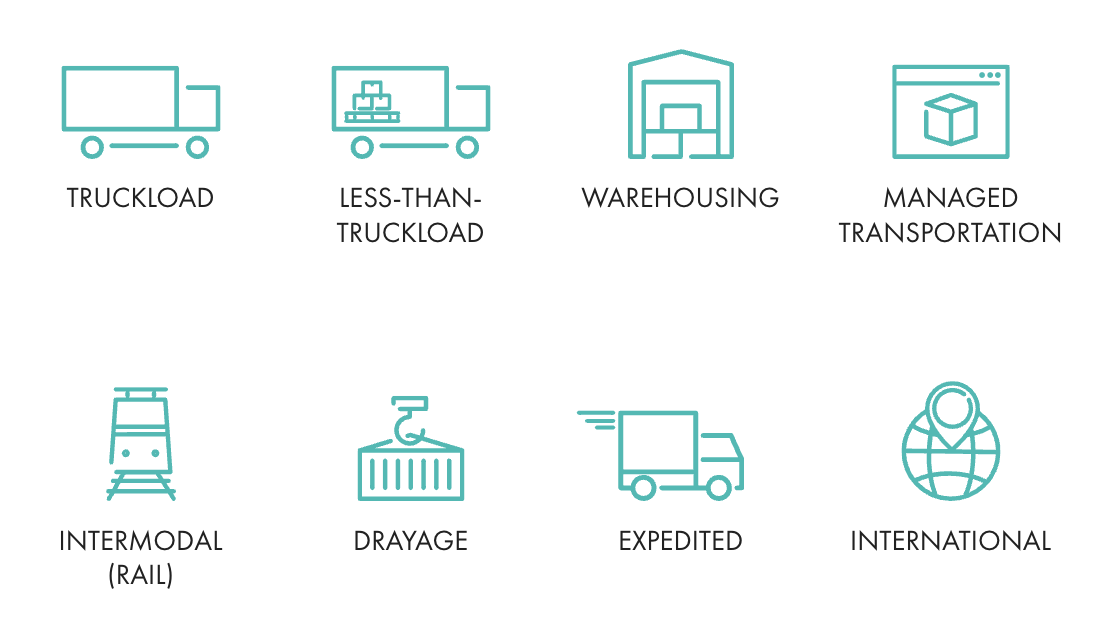
⭐ Cutting-Edge Technology Tools
Keep track of your shipments with real-time visibility though our technology applications.
Learn about our technology⭐⭐⭐ Exceptional Service
We work with trusted carrier relationships who have a track record of delivering your products safely and on time.
Don’t Just Take Our Word For It!
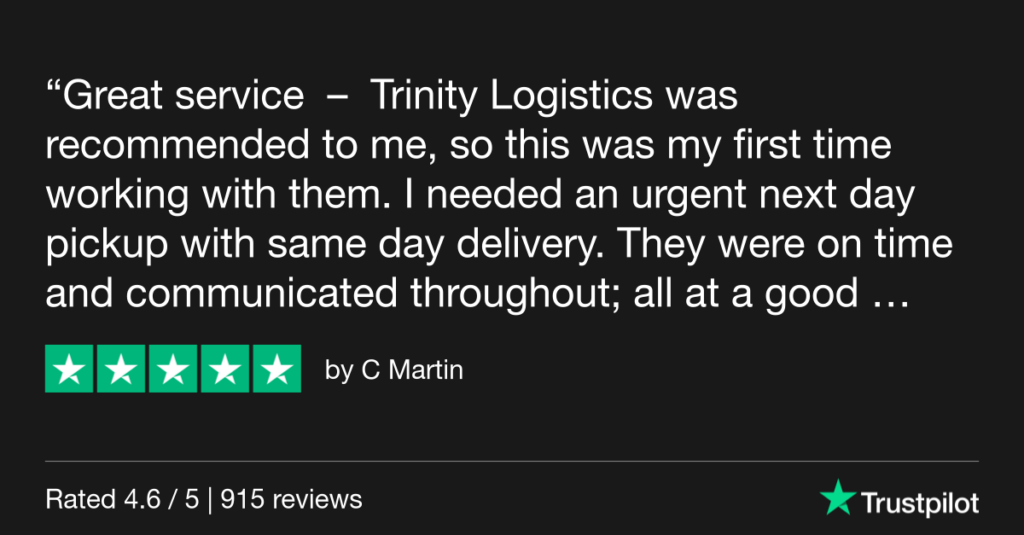
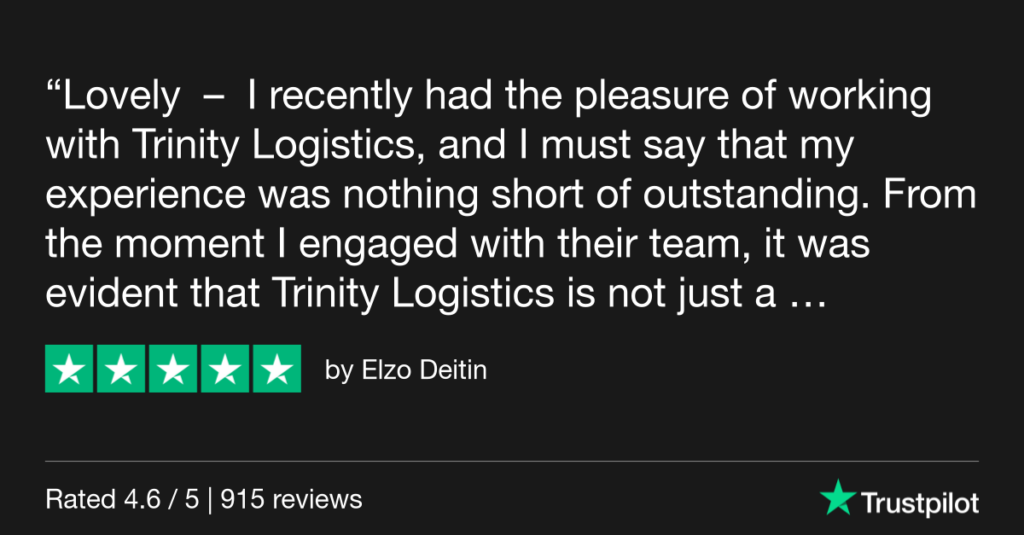
WE’RE A PROUD PROVIDER FOR
schedule Your Free Logistics Analysis
Don’t miss out on this chance to optimize your logistics and increase your company’s profits and productivity. Schedule time to meet with Trinity experts, Anthony, Jillian, or Keith, to discuss your current operations and find time and peace of mind with your own customized Trinity Logistics solution.
Schedule a meeting with one of these Trinity experts at the Seafood Expo:

Has 20+ years of experience working with seafood customers
Meet with Anthony
Has worked with some of the world’s largest seafood suppliers for 8+ years
Meet with Jill
Enjoys working on drayage, domestic transportation, and temp-controlled storage options for seafood customers
Meet with Keith
Expert in logistics management of both fresh and frozen seafood
Meet with BenStay up to date on the latest information on conditions impacting the freight market, curated by Trinity Logistics through our Freightwaves Sonar subscription.
Rising Tide of Rejection
Continuing our theme of tender rejection rates being a leading indicator of freight rates, the momentum gained over the last few months continues.
While the tender rejection rate (Figure 1.1) for the overall U.S. (blue line) briefly touched the 10 percent marker, it has retreated. However, it still appears to be slowly climbing, currently sitting just below eight percent. Being 300 basis points above the mark a year ago is a big deal and shows the relationship that exists between carriers saying “no thank you” to a shipment offered to them and the continuing retreat in carrier capacity.
Further, the rejection rate on refrigerated shipments (yellow line) has continued its run of outpacing the overall U.S. rejection rate for the past eight months. Colder than normal temperatures across much of the country has contributed to the need for reefer unit trailers to keep product from freezing. Shippers, especially those that play in refrigerated commodities, need to ensure they are flush with carrier and broker capacity, and should anticipate rate increase requests from their providers.

Speaking of capacity, we continue to see the slow trickle of carriers leaving the market. Looking at the past year, the trend for 2025 is we will see capacity decline at a three-to-five percent pace. Figure 2.1 shows the net change in carrier authorities, for the most part staying in the negative territory.
Looking further into the loss of capacity, the teal line shows the change in authority for micro fleets (one-to-five trucks). This is typically the owner operator community. Increases in costs to operate, as well as equipment where these carriers may be upside down on payments, has caused several to retreat from operating in the industry.

Calm Waters Ahead
Finally, a potential strike at East Coast and Gulf ports was averted for a second time. This is certainly good news as shippers continue to pull forward orders in anticipation of tariffs being imposed on import volume.
Just a few years ago, East Coast ports were seeing almost half of the U.S. import volume flow through their ports. Much of this shift was due to labor and operations issues on the West Coast. We are now seeing that reverse course.
East Coast ports are handling 41 percent of inbound ocean freight, while West Coast ports are up over the same two-year period, from 37 percent to 47 percent. With ILWU voting in favor of a contract that extends through mid-2028, and East and Gulf port workers agreeing on a six-year deal, a sense of calm should come to shippers and manufacturers that depend on our ports to receive their freight.
Stay Up To dAte
Looking for a more frequent update? Subscribe to our newsletter and receive the top five logistics articles of the week every Friday morning by selecting “Weekly News Update” when you select your preferences.
Get Weekly News Updates in Your InboxStay up to date on the latest information on conditions impacting the freight market, curated by Trinity Logistics through our Freightwaves Sonar subscription.
CANARY IN THE CAVE
Data is everywhere, both on a macro and micro level. How this data is interpreted and reported, and the contradictions it can create, has the potential to leave one wondering just what to believe.
For years now, I have been, pretty much daily, watching like a hawk the ebb and flow of tender rejections (Figure 1.1). While this is focused on the contact freight market, what happens on the contract side absolutely has an impact on the spot market side. The last year plus has been pretty vanilla, with rejection rates almost negligible.
This pales in comparison to just a few years ago when carriers said “no” to shipments 30-plus percent of the time. While the current six percent rejection rate won’t set off many alarms, it is noteworthy in its trend. Heck, just six months ago, the rejection rate was hovering below three percent. Yes, there is seasonality that plays into the rejection rate, but seasonality also existed in 2023, and the rejection rate lagged during the fourth quarter of the year. While there will be some dips along the way over the next six months, I expect the upward trend to continue.

LOOMING STRIKES & DISRUPTION
Many in the industry breathed a sigh of relief when the short-lived port strikes on the East and Gulf Coasts were settled. However, while there was agreement on several issues, the automation at the ports loop remained open.
We are fast approaching the 90-day period for resolve in January, and the threat of another shutdown looms. Combined, the East and Gulf Coast ports provide service for incoming and outgoing ocean containers for more than half of the volume in the U.S.
So, what should you be prepared for if a second strike were to happen?
👉 Like it or not, we are dependent on unfinished and finished goods from overseas. Not being able to receive those goods will cause shortages on things like groceries, electronics, and clothing to name a few.
👉 The U.S. economy’s dependence on consistent flow of goods in and out of our country is to the tune of about four billion dollars per day. Even a week-long strike has the potential to severely delay the flow of goods around the ports for a month-plus.
👉 While most U.S. businesses would feel the effects, small businesses would be the most impacted as their already thin profit margins would be challenged by increased costs for goods along with a tight labor market and inflation.
👉 It’s not just consumer-ready goods. The ports play a role in the preparedness for emergency situations and defense posture.
We are already seeing the surge in import volume, up about eight percent versus a year ago as shippers look to get ahead of potential tariffs and now a labor shortage. Couple this with a downward trend in over-the-road capacity (Figure 2.1), and you have a recipe to further accelerate trucking rates.
U.S. shippers need to be reviewing their carrier and broker partners for compliance in the coming months. While many have not had the need recently, they should consider adding extra companies to their routing guides.

Stay Up To dAte
Looking for a more frequent update? Subscribe to our newsletter and receive the top five logistics articles of the week every Friday morning by selecting “Weekly News Update” when you select your preferences.
Get Weekly News Updates in Your InboxB2B credit management has evolved since 2019. Here’s how to ensure your credit department succeeds.
The COVID-19 pandemic drastically changed the world, businesses, and their credit departments. It reshaped our economy. In order to meet the changing business landscape, credit managers have adapted quickly to maintain their companies’ financial stability.
Let’s briefly review the economy before the pandemic started. This will give us a clearer picture of the changes that have happened and the difficulties B2B credit managers now face. We’ll look at how your sales team can become a credit ally and close with tips on how to decision today’s B2B credit with success.
Pre-Pandemic Stability
Before COVID-19, the economy experienced comparatively stable growth. Companies were generally optimistic about their clients’ creditworthiness. The approval process for B2B credit managers was a relatively simple routine. They usually assessed customer creditworthiness based on financial statements, credit reporting, and industry benchmarks. Once a credit limit was approved, customers were generally given net payment terms.
Pandemic-Induced Shifts
The pandemic triggered a series of economic shifts that profoundly affected B2B credit practices. Government stimulus programs, supply chain disruptions, and inflation surges all contributed to a climate of uncertainty and volatility.
According to the National Association of Credit Management (NACM), total bankruptcy filings increased 18 percent year-over-year (YoY) in 2023.
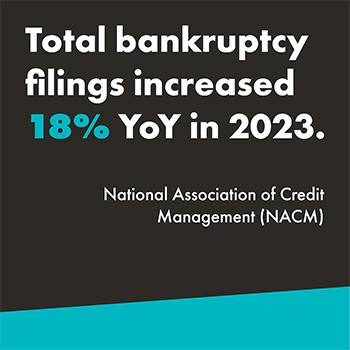
As a result of these changes, businesses became more cautious about extending credit and credit managers had to adopt a more rigorous approach to risk assessment.
6 Key Changes in B2B Credit Management

In-Depth Credit Risk Assessments
Economic changes caused credit managers to become more reliant on data analysis to assess creditworthiness. This includes using financial modeling tools to assess a company’s ability to meet its debt obligations. Credit bureaus and alternative data sources are also leveraged to achieve a comprehensive view a customer’s financial health.
Tighter Credit Terms
As businesses become more risk-averse, they are tightening their credit terms. This can involve shortening payment terms (e.g., from net 60 to net 30), reducing credit limits for existing customers, and issuing lower initial credit lines for new customers. According to a March 2024 report by HighRadius, 52 percent of companies seek extended terms – quite the opposite view. The same report shows that 17 percent of customers blatantly ignore credit terms while another 48 percent intentionally delay payment. This can make building strong customer relationships difficult.

Increased Use of Credit insurance
The rise in economic uncertainty has led to a surge in demand for credit insurance. Credit insurance protects businesses from monetary loss if a customer defaults on their payments. A 2023 survey by AU Group shows that since the third quarter of 2022, the number of business failures in almost every region of the world has risen. In line with that statistic, credit insurers expect growth in their sales over the next six years.
Growing Use of Digital Credit Tools
The pandemic has accelerated the adoption of digital credit tools and automation. Tasks like processing credit applications, credit checks, and collections are now being completed faster and allowing credit teams to focus on exception management.
Collection Challenges
The pandemic caused many businesses to experience cash flow disruptions. It’s made it more difficult for some companies to meet and/or maintain on time payments.
Cash Flow Management
Businesses are focusing on more effective ways to manage their working capital. This can include reworking their collection processes and closely tracking inventory levels.
Opportunity Emerges
All these changes have significantly affected credit managers and their teams. Now, they carry heavier workloads and face increased pressure to mitigate credit related risks. They also need to be able to adapt to rapid changes that may happen in today’s economy.
While these changes may have increased the burden on credit managers, they’ve also created opportunities for collaboration with sales teams. By working together, credit managers and sales teams can better service their businesses and customers.
5 Ways B2B Credit Managers Can Seek Help from Sales
In today’s risky and fraud-ridden environment, the sales team support in customer onboarding and credit is vital. Credit and sales teams must collaborate to ensure a positive and seamless customer experience. Here are some tips to foster better collaboration:
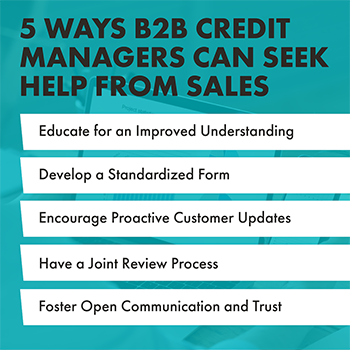
Educate for an Improved Understanding
Sales teams are crucial in helping gather customer information to assess creditworthiness. Credit managers can help sales teams understand the importance of collecting this information. Sharing its use and how having it can make the approval process faster helps, too.
Develop a Standardized Form
A standardized customer information form ensures sales teams collect all the required information. This can help streamline the credit approval process.
Encourage Proactive Customer Updates
Credit teams must stay updated on customer developments. Encourage the sales team to proactively share any relevant customer updates with the credit department. Discuss what information is “relevant”, so everyone is on the same page.
Have a Joint Review Process
Joint sales and credit reviews can ensure both teams understand customer creditworthiness. They can help prevent incidents where a customer is given an okay by sales and later is deemed to be a credit risk. At the same time, joint reviews will strengthen the relationship between sales and credit while improving the customer experience.
Foster Open Communication and Trust
Open communication and trust are essential for effective collaboration between teams. Credit managers should be available to answer sales teams’ questions and provide guidance on any credit-related matters.
Is This the New Normal for B2B Credit Management?
It appears this “new normal” of post-pandemic business is here to stay, and it’s changed credit management for the foreseeable future. Because of this, we must have a more strategic and data-driven approach to B2B credit management. Those credit teams that adapt to these changes and improve collaboration with sales will be well-positioned to thrive in today’s economy. Furthermore, those who stay flexible and committed to delivering exceptional service will aid their company’s success. Will your credit team be the ones to hold revenue back or help drive it forward?
Get More Content Like This In Your InboxAbout the Author

Tracy Mitchell currently holds the position of Director of Accounts Receivable at Trinity Logistics. She has worked at Trinity for nine years, with over five years of those in credit management. She holds a Credit Business Association (CBA) designation. With a deep understanding of the industry’s dynamics, she has firsthand knowledge and provides the company with invaluable insights into the complexities of credit risk assessment, collections, and sales alignment.
Stay up to date on the latest information on conditions impacting the freight market, curated by Trinity Logistics through our Freightwaves Sonar subscription.
What to Expect in the Short-Term
Well, so much for a recession. The U.S. is anticipating year-over-year growth of 2.8 percent in 2024 with regards to gross domestic product (GDP). That percentage of growth appears to be trending less in calendar 2025, with moderate growth forecast through the end of 2029 (Figure 1.1).
Generally, for every one percent of GDP growth, that typically translates into 1.5 percent growth in over-the-road truckload volume. Based on those projections, we expect freight volumes to climb by four to five percent in the coming year.
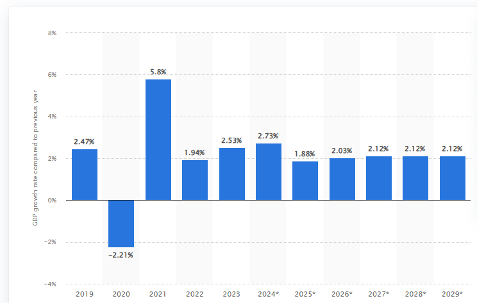
Conditions are also turning more favorable for a pendulum swing to the side of the carriers. Two reasons for the bullish outlook – dwindling capacity and tariffs (be it threat or real), simple supply and demand.
INCHING CLOSER TO BALANCE
On the capacity side, the spread between contract and spot rates, which was near $0.80 per mile in the middle of 2022, has now fallen below $0.50 per mile. Keep in mind contract is almost always above spot sans latter 2020 and early 2021.
The gap has closed primarily due to contract rates receding, from the $2.30 range in early ’24 to now being $0.15 less, as illustrated by. Figure 2.. Figure 2.2 shows the net change in for-hire carriers versus the tender rejection rate. Since mid-2022, carriers have started to shun the market as higher costs to operate & lower rates made sustainability a challenge.
Where does shrinking capacity first show up? In the tender rejection rates. Carriers will say no to a guaranteed rate load either because they have no equipment in the area or there is a more favorable paying load available.
Rejection rates cresting the five percent mark may not sound significant, but keep in mind rejection rates were in the two to three percent range as we started this calendar year. Eight to 10 percent is a more balanced market, and we are close to that. Usually, rejection rates in double digits signify more pricing leverage is held by the carrier community.
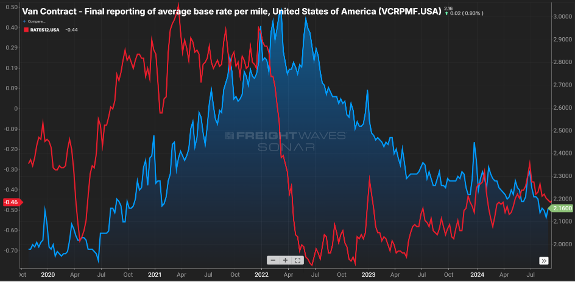
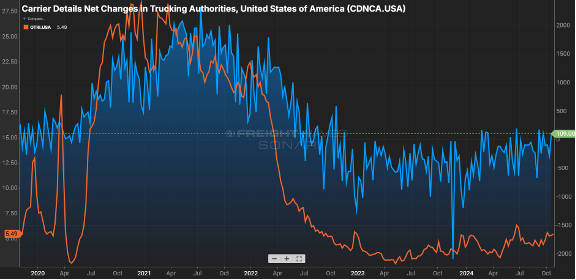
The other driving factor is around demand. While there are some sectors showing slight gains, the November election could be the spark that drives a glut of freight movement.
With Republicans poised to control the White House and Congress, impending tariffs will drive a flurry of activity as shippers look to move goods prior to an imposed increase in cost, This is likely a short-term surge as “too much inventory” is a real thing, and once tariffs are imposed, consumers ultimately will feel the brunt of increased costs and could hamper purchasing. However, the next pivot point will be around movement of production to domestic U.S. or near-shore locations.
After a blah few years, things are about to get interesting.
Stay Up To dAte
Looking for a more frequent update? Subscribe to our newsletter and receive the top five logistics articles of the week every Friday morning by selecting “Weekly News Update” when you select your preferences.
Get Weekly News Updates in Your InboxIn a world so reliant on digital technology, we often expect (and hope) that our software will be stable. Yet even the most reliable technology platforms can falter. Take the recent digital disruption felt by businesses affected by the CrowdStrike global outage for example.
The recent global outage involving CrowdStrike, one of the world’s leading cybersecurity companies, was a stark reminder that no system is entirely immune to disruption. It’s a harsh reality, but one we need to face head-on. Here’s how the recent outage affected businesses and, most importantly, some essential tips to ensure your operations remain resilient. Read on to safeguard your company’s digital future.
Crowdstrike Global Outage Event
On July 19, 2024, CrowdStrike released an update for its Falcon Sensor software. The update caused a significant global IT outage, crashing millions of Windows computers and displaying what you might otherwise know as the “Blue Screen of Death.”

Around 8.5 million systems worldwide were affected. The outage interrupted businesses of all kinds, including airlines, healthcare, banks, and more. Here are a few examples of the disruption the outage caused.
Airlines
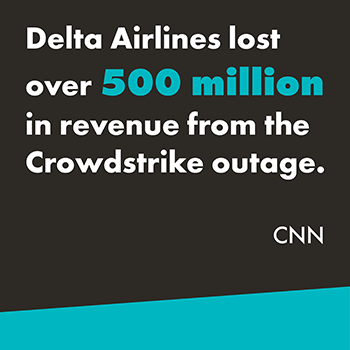
At LaGuardia Airport, the outage caused their baggage handling system to fail, causing significant delays and widespread operational disarray. Wait times were extensive, and many passengers missed their flights.
Delta Airlines was the largest airline affected by the outage. The company had to reset over 40,000 servers and manually cancel 5,000 flights, losing over 500 million dollars in revenue.
Healthcare
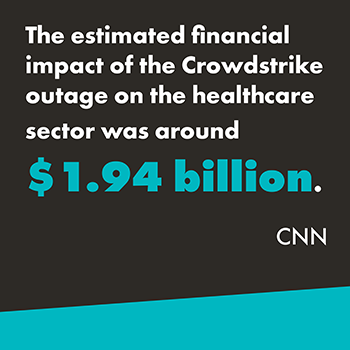
Hospitals like the Mayo Clinic, Cleveland Clinic, and Mass General Brigham faced system crashes that affected patient care and administrative functions. Electronic health records went offline, delaying medical procedures and patient admissions. The estimated financial impact on the healthcare sector alone was around $1.94 billion.
Banking

Financial institutions like JPMorgan Chase and Bank of America suffered considerable downtime. Transactions, online banking services, and customer support were affected. The inability to process anything led to customer dissatisfaction and financial losses. The estimated impact on the banking sector contributed heavily to the global economic damage totaling at least $10 billion.
Preventing Digital Disruption in Your Business
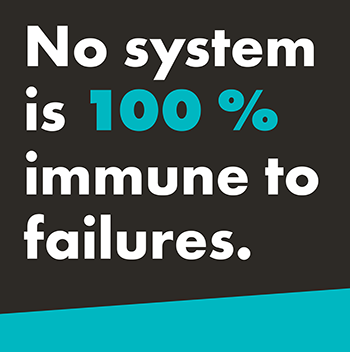
The CrowdStrike global outage underscored the importance of being prepared for the unexpected. While such events may be rare, businesses should understand that no service is exempt from disruption. But don’t panic. You can use the practices below to reduce any impact should an incident like the CrowdStrike outage ever happen.
Have a Strong Incident Response Plan
A well-structured Incident Response Plan (IRP) is crucial for navigating outages. For many businesses, the CrowdStrike outage was a wake-up call about the importance of having a detailed IRP. Most organizations now have plans for cyber threats but remain unprepared for a service outage.
Organizations need well-defined and practiced IRPs. An effective IRP ensures faster recovery and coordinated actions during outages.
A proper incident response plan should have the following components:
- The organization’s incident response strategy and how it supports business objectives
- Roles and responsibilities involved in incident response
- Procedures for each phase of the incident response process
- Communication procedures within the incident response team, with the rest of the organization, and external stakeholders
- How to learn from previous incidents to improve the organization’s security posture
Without a solid IRP, chaos can arise when essential tools and services go down. Time is so critical in these kinds of situations. Companies that don’t respond to incidents fast often face increased downtime and direct revenue loss.
According to a SANS report, companies without a proper IRP take 54 percent longer to contain incidents that cause downtime. Additionally, a study from Ponemom Institute found that organizations without an effective IRP team experienced 54 percent more downtime compared to those with one.
Having an IRP in place is crucial, but the second most important aspect is testing it often! This ensures that the plan is effective, team members are familiar with their roles, and potential gaps are identified before an actual incident occurs.

Practicing the IRP should be done annually or after a major change to your process. Planning and organization are the only ways to mitigate significant disruption. It’s always best to be prepared for the worst!
Review Your Software Deployment Practices
Deploying new software can be a very complex process, especially when it is dependent on other applications or systems. The CrowdStrike global outage was caused directly by this issue, as it was dependent on the Windows operating system.
Here are some best practices for establishing an effective deployment process.
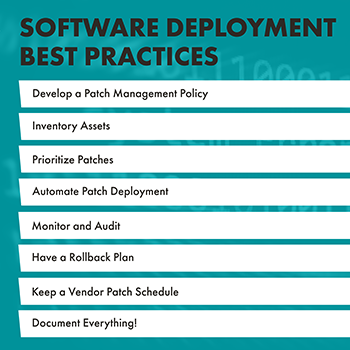
Develop a Patch Management Policy
Define a comprehensive policy that details the procedure for managing patches, specifying roles, responsibilities, and schedules.
Inventory Assets
Keep an updated inventory of all hardware and software assets that need patching.
Prioritize Patches
Assess and schedule patches based on the severity of vulnerabilities and the importance of the systems they impact.
Before deploying patches to production environments, test them in a controlled setting. This way, you can be sure they won’t cause any issues.
Automate Patch Deployment
Automated tools are excellent for streamlining the patch deployment process. This can reduce the risk of human error and ensure timely updates.
Monitor and Audit
Continuously track the patching process and audit patch deployments to ensure compliance and effectiveness.
Have a Rollback Plan
Have a rollback plan in place. This allows you to revert to a previous state should a patch cause problems.
Keep a Vendor Patch Schedules
Stay informed about each vendor’s patch release schedule to plan and prepare for upcoming updates.
Document Everything
Keep detailed records of all patching activities, including what was patched, when, and by whom.
Assess Your Vendor Relationships
Periodic assessment of third-party vendors is necessary to ensure resilience. The CrowdStrike outage has prompted many organizations to reconsider their vendors. Businesses should assess vendor relationships to confirm they meet the organization’s risk tolerance and operational needs.
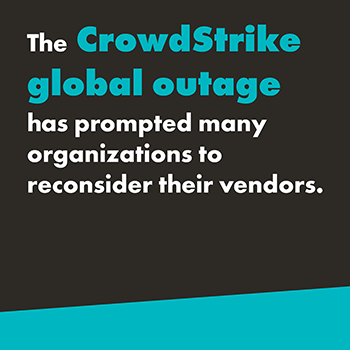
Scheduling annual assessments can help keep this task from being forgotten. Assessments should include one for vendor risk and a security questionnaire.
Vendor Risk Assessment
This assessment evaluates the potential risks that the vendor may introduce to your organization. This includes understanding the vendor’s operations, data handling practices, and risk profile.
Security Questionnaire
This should be comprehensive and help you understand the vendor’s security policies, practices, and standards. Topics may include encryption, incident response, access controls, and employee security training.
Consider Diversification
Companies may wish to review their diversification processes when relying on critical software to run their operations. As highlighted by the CrowdStrike outage, over-dependence on a single software solution can expose the business to significant risks. This can include operational disruptions due to software failures, security vulnerabilities, or vendor instability.
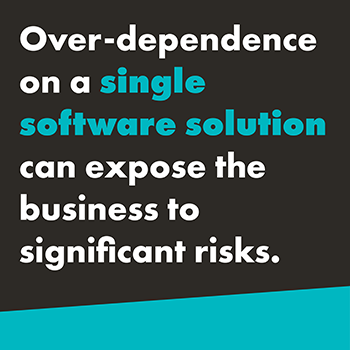
Software diversification helps you not be reliant on one system. This can provide contingency options and flexibility in the face of unexpected challenges. By incorporating several complementary software tools or services, companies can enhance resilience, maintain business continuity, and mitigate potential risks.
Building Digital Resilience in the Face of Uncertainty
While incidents like the CrowdStrike outage can be rare, their impact can be severe. The unpredictability of such events can be scary, but with these proactive practices, there’s little to fear. Remember, a resilient business is a prepared business. By taking these steps, you can protect your operations and buckle in for a smooth ride in the digital landscape.
Get More Content Like This In Your InboxABOUT THE AUTHORS
Willy Rojas

Engineer II, Infrastructure
Willy has been with Trinity Logistics for eight years. He’s held several other IT positions while here, starting as a Service Desk Intern to Senior Service Desk, IT Systems Administrator II, and Infrastructure Engineer II. Willy finds cybersecurity fascinating because it’s often changing and giving him something new to learn. He also finds satisfaction in knowing that the work he does every day is important, from keeping confidential information secure to keeping business operations running smoothly.
Dustin O’Bier

Manager, Infrastructure
Dustin has been working at Trinity for 21 years. Previous positions he’s held include Help Desk Specialist, System Administrator I, Senior System Administrator, and IT Systems Manager. Dustin enjoys the collaborative aspect of his role. He loves working alongside a team of people to solve complex problems. Dustin’s main focuses as Manager in Infrastructure cover three distinct aspects; the Core Infrastructure of the Regional Service Centers (RSCs), Security, and the company’s Cloud practice. He finds each focus brings a unique set of challenges, making his role dynamic and engaging.
Trinity Logistics, a leading third-party logistics provider (3PL), is thrilled to share that its Technology Team has been recognized as one of the Top 10 Technology Teams by OnConferences. This prestigious award honors organizations that have demonstrated exceptional innovation, technical expertise, and a commitment to delivering leading solutions.
Trinity’s Technology Team plays a vital role in supporting the company’s operations and delivering exceptional service to its clients. The Team is responsible for developing and implementing cutting-edge technology solutions that enhance efficiency, improve customer service, and drive growth.
“The Trinity Technology Team continues to deliver innovative solutions driving business outcomes and effectively supporting our Team Members,” said Russ Felker, Chief Technology Officer at Trinity Logistics. “From cybersecurity to integrations to data availability to custom development, they consistently provide exemplary service and support for Team Trinity and its partners.”
OnConferences is a leading provider of educational conferences and networking opportunities for professionals across many industries. Its Top 10 Technology Teams award is determined through peer and community voting. Voters are instructed to select teams that they have seen make a significant impact on their own organization or within the broader industry, contribute to their professional community through thought leadership, drive innovation, and demonstrate exceptional leadership.
Trinity’s Technology Team and their dedication to excellence, innovative practices, and leadership have set them apart as a top-performing team. The Team has made remarkable achievements like a full migration to the cloud in only eight months, multiple new customer and vendor integrations, improved and differentiated functionality within Trinity’s custom Transportation Management System (TMS), and increased data availability for Team Members and the company’s Agent partners. These accomplishments helped them stand out from the rest of the submissions, distinguishing them as an outstanding Team.
Trinity Logistics is committed to investing in purposeful technology and great talent to ensure its respected culture and exceptional service stay at the forefront of its continued success. As the company continues to grow and evolve, this recognition serves as a testament to that ongoing promise.
LEARN MORE ABOUT TRINITY LOGISTICS TECHNOLOGY VIEW THE FULL LIST OF WINNERSAbout Trinity Logistics
Trinity Logistics is a Burris Logistics Company, offering People-Centric Freight Solutions®. Our mission is to deliver creative logistics solutions through a mix of human ingenuity and innovative technology, enriching the lives of those we serve.
For the past 45 years, we’ve been arranging freight for businesses of all sizes in truckload, less-than-truckload (LTL), warehousing, intermodal, drayage, expedited, international, and technology solutions.
We are currently recognized as a Top Freight Brokerage by Transport Topics, a Green Supply Chain Partner by Inbound Logistics, and a Top Company for Women to Work for in Transportation by the Women in Trucking Association.
About OnConferences
OnConferences is a leading organization that connects top professionals across various industries, promoting collaboration, innovation, and thought leadership. Through conferences, awards, and networking opportunities, OnConferences provides a platform for executives and organizations to exchange insights, fostering growth and development within their respective fields.
Trinity Logistics, a leading third-party logistics provider (3PL) offering logistics and supply chain solutions, proudly shares its recognition as a Top Company for Women to Work for in Transportation by the Women in Trucking Association (WIT) for the sixth consecutive year.
This prestigious honor highlights companies that demonstrate a commitment to gender diversity, inclusivity, and career advancement for women in the transportation industry. Trinity Logistics ranked highly in these areas, and the nomination was validated by an industry-wide vote involving over 31,000 transportation professionals.
“As someone who has spent my career in male-dominated industries and being relatively new to Trinity with just over two years here, I feel an immense sense of pride that Trinity has been recognized for the sixth consecutive year as a Top Company for Women to Work for in Transportation,” said Carlie Crouch, Director of Talent Management at Trinity. “There is a deep sense of understanding and support at Trinity—as mothers, coworkers, and friends. The ability to balance all aspects of my life while feeling seen and heard as a woman is something I truly value. As the Director of Talent Management, I enjoy sharing with future team members the incredible opportunities available at Trinity for women to thrive and succeed. I’m proud to be part of Team Trinity.”
Key features that distinguished Trinity Logistics included its positive and family-friendly culture that supports diversity, competitive pay, quality benefits for employees and their families, ample time off, flexible work arrangements to encourage work-life balance, and extensive professional development opportunities.
“This achievement reflects our commitment to creating an inclusive environment where every Team Member can thrive,” said Amy Proctor, Senior Vice President of Logistics Solutions at Trinity. “We continue to empower our Team to reach new heights. In my own journey here, I’ve seen firsthand how our culture of collaboration and growth makes a real difference. The opportunities for leadership development, mentorship, and professional growth have shaped my career and allowed me to contribute in meaningful ways. It’s inspiring to see the impact women have across our company and I’m proud to be part of a Team that champions opportunity for all.”
To date, Trinity employs over 400 Team Members across six Regional Service Centers, with more than half of them being women. Notably, 16.7 percent of these women hold management or leadership roles, including the current President, Sarah Ruffcorn, who also serves as co-chair on the Women in Logistics Committee with the Transportation Intermediaries Association (TIA).
“We’re incredibly honored to receive this award for a 6th year!” said Sarah Ruffcorn, President of Trinity Logistics. “This achievement reflects our amazing Team that continues to live and create a culture in which anyone can thrive. We’re proud of our efforts to continuously offer a supportive environment, ensuring our Team Members have the opportunity to succeed and grow.”
Trinity Logistics thanks WIT for the recognition and wants to congratulate all the companies that made the list.
LEARN MORE ABOUT TRINITY LOGISTICSAbout Trinity Logistics
Trinity Logistics is a Burris Logistics Company, offering People-Centric Freight Solutions®. Our mission is to deliver creative logistics solutions through a mix of human ingenuity and innovative technology, enriching the lives of those we serve.
For the past 45 years, we’ve been arranging freight for businesses of all sizes in truckload, less-than-truckload (LTL), warehousing, intermodal, drayage, expedited, international, and technology solutions.
We are currently recognized as a Top Freight Brokerage by Transport Topics, a Green Supply Chain Partner by Inbound Logistics, and holds a bronze sustainability rating by EcoVadis.
